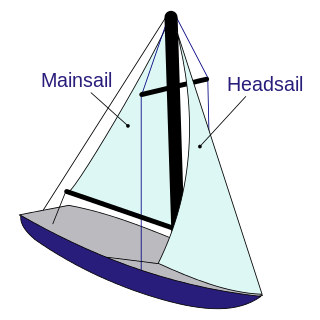
A sailboat or sailing boat is a boat propelled partly or entirely by sails and is smaller than a sailing ship. Distinctions in what constitutes a sailing boat and ship vary by region and maritime culture.

A Thames sailing barge is a type of commercial sailing boat once common on the River Thames in London. The flat-bottomed barges, with a shallow draught and leeboards, were perfectly adapted to the Thames Estuary, with its shallow waters and narrow tributary rivers. The larger barges were seaworthy vessels, and were the largest sailing vessel to be handled by just two men. The average size was about 120 tons and they carried 4,200 square feet (390 m2) of canvas sail in six working sails. The mainsail was loose-footed and set up with a sprit, and was brailed to the mast when not needed. It is sheeted to a horse, as is the foresail; they require no attention when tacking. The foresail is often held back by the mate to help the vessel come about more swiftly.

Thomas W. Lawson was a seven-masted, steel-hulled schooner built for the Pacific trade, but used primarily to haul coal and oil along the East Coast of the United States. Named for copper baron Thomas W. Lawson, a Boston millionaire, stock-broker, book author, and president of the Boston Bay State Gas Co., she was launched in 1902 as the largest schooner and largest sailing vessel without an auxiliary engine ever built.

The S.S.S.Lotus is a historic gaff rigged schooner. Her home port is Sodus Bay in Wayne County, New York, United States. She is owned and operated by the "Friends of the Schooner Lotus."
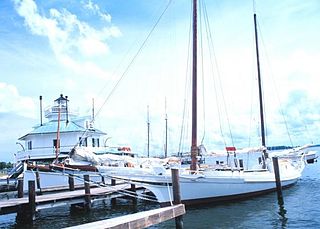
The bugeye is a type of sailboat developed in the Chesapeake Bay for oyster dredging. The predecessor of the skipjack, it was superseded by the latter as oyster harvests dropped.

L. A. Dunton is a National Historic Landmark fishing schooner and museum exhibit located at the Mystic Seaport Museum in Mystic, Connecticut. Built in 1921, she is one of three remaining vessels afloat of this type, which was once the most common sail-powered fishing vessel sailing from New England ports. In service in New England waters until the 1930s and Newfoundland into the 1950s. After a brief period as a cargo ship, she was acquired by the museum and restored to her original condition.
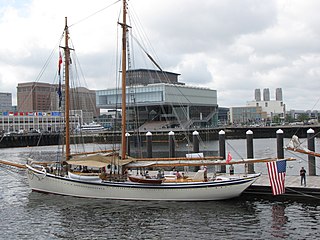
The American Eagle, originally Andrew and Rosalie, is a two-masted schooner serving the tourist trade out of Rockland, Maine. Launched in 1930 at Gloucester, Massachusetts, she was the last auxiliary schooner to be built in that port, and one of Gloucester's last sail-powered fishing vessels. A National Historic Landmark, she is also the oldest known surviving vessel of the type, which was supplanted not long afterward by modern trawlers.

Grace Bailey, also known for many years as Mattie, is a two-masted schooner whose home port is Camden Harbor, Camden, Maine. Built in 1882 in Patchogue, New York, she is one of four surviving two-masted wooden-hulled schooners, once the most common vessel in the American coasting trade. She was one of the first ships in the fleet of historic vessels known as "Maine windjammers", which offer cruises in Penobscot Bay and the Maine coast, entering that service in 1939. She last underwent major restoration in 1989–90. She was declared a National Historic Landmark in 1992.
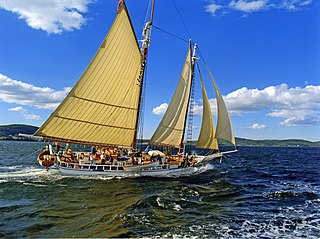
Isaac H. Evans, originally Boyd N. Sheppard, is a two-masted schooner berthed in Rockland, Maine. She is a Maine windjammer, serving the tourist trade. Built in 1886 in Mauricetown, New Jersey, she is the oldest of a small number of surviving oyster schooners, used in service of the oyster harvesting industry in the coastal waters of New Jersey. She was declared a National Historic Landmark in 1992.

Lewis R. French is a gaff-rigged topsail schooner sailing out of Camden, Maine as a "Maine windjammer" offering 3 to 6 night cruises to tourists. Built in 1871, she is the oldest known two-masted schooner in the United States, and one of a small number of this once-common form of vessel in active service. The ship was designated a US National Historic Landmark in 1992.
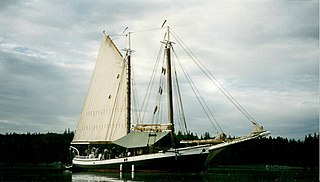
Mercantile is a two-masted schooner berthed in Camden Harbor, Camden, Maine. Built in the 1914-16 on Little Deer Isle, Maine, she is one of a small number of such vessels still afloat from a time when they were one of the most common cargo vessels of the coasting trade. Designated a National Historic Landmark in 1991, she now serves as a "Maine windjammer", offering multi-day sailing cruises to tourists.

The three-masted schooner Victory Chimes, also known as Edwin and Maud or Domino Effect, is a US National Historic Landmark. She is the last surviving Chesapeake Ram schooner. The boat on the Maine State Quarter is meant to resemble the Victory Chimes.

The Cora F. Cressey was a five masted 273 feet (83 m) wooden-hulled freight schooner operating in the coasting trade along the east coast of the United States. Built in 1902, it served in that trade until 1928. After serving for a time as a floating nightclub, its hulk was towed to the Keene Narrows in Bremen, Maine, where it was scuttled to serve as a breakwater for a lobster operation. Despite its deteriorating condition, the hulk is one of the largest surviving wooden hulls in the United States. It was listed on the National Register of Historic Places in 1990.

The Shearwater is an 81.5-foot (24.8 m) wooden schooner docked in Lower Manhattan in New York City in the U.S. state of New York. The schooner was designed by Theodore Donald Wells and built by the Rice Brothers Corporation in East Boothbay, Maine in 1929. During World War II, it was requisitioned into the United States Coast Guard to patrol for German U-boats. The Shearwater completed a circumnavigation of the world in the early-1980s and later worked as a research laboratory for the University of Pennsylvania's Institute of Environmental Medicine. Docked about 200 yards (180 m) west of the site of the World Trade Center, it is operated by Manhattan by Sail, which gives 90-minute-long tours of New York Harbor, and is licensed to carry 48 passengers. The schooner was listed on the National Register of Historic Places in 2009.

Coaster II, also known as Quissett, is a two-masted sailing schooner moored at the far western end of the Main Pier at Mattson Lower Harbor Park, off Harbor Drive in Marquette, Michigan. She was listed on the National Register of Historic Places in 1989.

Wendameen is a historic schooner normally berthed at the Maine State Pier on Commercial Street in Portland, Maine. She is a two-masted auxiliary rigged schooner, designed in 1912 by the noted naval architect John G. Alden. She is now owned and operated by the Portland Schooner Company, which offers sailing tours of Casco Bay, using Wendameen and Bagheera. Wendameen was listed on the National Register of Historic Places in 1992.

Surprise is a two-masted former racing schooner berthed in Camden, Maine. Built in 1917–18 in Rockport, Massachusetts, she is one of a small number of surviving schooners designed by noted naval architect Thomas F. McManus. She currently serves as a "windjammer", providing daily cruises in Penobscot Bay. She was listed on the National Register of Historic Places in 1991.

The schooner Timberwind is a historic former pilot boat, now berthed in Portland, Maine. Built in 1931, she served as a pilot boat in Portland Harbor until 1969, and was then converted into a schooner as part of the Maine "windjammer" tourist fleet. She is one of a very small number of early 20th-century purpose-built pilot boats that has survived major alteration, and was listed on the National Register of Historic Places in 1992. She moved to Rockport in 1969 and then to Belfast in 2015. She was purchased by the Portland Schooner Company in 2018.
The General Butler was a schooner-rigged sailing canal boat that plied the waters of Lake Champlain and the Champlain Canal in the United States states of Vermont and New York. Built in 1862 and named for American Civil War General Benjamin Franklin Butler, she sank after striking the Burlington Breakwater in 1876, while carrying a load of marble. Her virtually intact wreck, discovered in 1980, is a Vermont State Historic Site and a popular dive site; it was listed on the National Register of Historic Places in 1998.
Gitana is a classic yacht built in 1936 after plans of American Naval Architect John Alden.




















